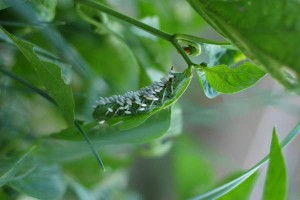Each year as we struggle with hornworms on our tomatoes, we’ve eyed with jealous interest those photos of parasitic wasps that prey on hornworms.
“What’s wrong with our hornworms,” we asked. “Are they not good enough?” Now, in our fifth year of growing tomatoes, we finally have braconid wasps on our hornworms. We’re so excited!
If this sounds like so much breathless hooey to you, know that hornworms are the bane of tomato growers. Blending in perfectly with the stem of the tomato plant when they’re young, these larvae silently munch on the leaves of the tomato plant and will eventually destroy it. In our worst year, 2011, they took down all our tomato plants and destroyed the crop. The most straightforward remedy for hornworms is to pick them off the plant and kill them, but in a bad year they can overwhelm you. Amanda and I remember days during 2011 when we would go out and pick off all the hornworms we could find in the morning, and then go back that afternoon and find just as many back again. So discouraging.
We’ve had considerable success with our hornworms since then by companion planting tomatoes with basil and marigold, and nowadays we just don’t plant tomatoes without at least a little basil alongside for company. By the way, basil can be quite expensive if you buy transplants. Instead, Amanda starts some basil from seed every spring and then moves them around as needed through the summer (we tried taking cuttings, but it didn’t work well).
 So that brings us forward to today, when we no longer find hornworms devastating but do continue to see them from time to time. Two days ago Amanda spotted this guy in the garden, so we decided to share the picture with you. Each of those white protrusions sticking out of the hornworm is the cocoon of a Braconid wasp. This hornworm is doomed! Braconid wasps use their ovipositor to inject eggs under the skin of the hornworm. When the eggs hatch the wasp larvae dine on the internal organs of the hornworm, literally eating it alive. Then they chew their way through the hornworms skin and spin that cocoon. In a few days the cocoons will open to reveal the adult braconid wasps, who will immediately begin looking for other hornworms upon which to prey.
So that brings us forward to today, when we no longer find hornworms devastating but do continue to see them from time to time. Two days ago Amanda spotted this guy in the garden, so we decided to share the picture with you. Each of those white protrusions sticking out of the hornworm is the cocoon of a Braconid wasp. This hornworm is doomed! Braconid wasps use their ovipositor to inject eggs under the skin of the hornworm. When the eggs hatch the wasp larvae dine on the internal organs of the hornworm, literally eating it alive. Then they chew their way through the hornworms skin and spin that cocoon. In a few days the cocoons will open to reveal the adult braconid wasps, who will immediately begin looking for other hornworms upon which to prey.
Braconid wasps are rarely more than half an inch in length and have no interest in biting or stinging humans. Most are black, but some are yellow or orange. Like thirsty football fans in a bar, we welcome them regardless of the color they’re wearing.